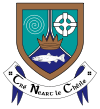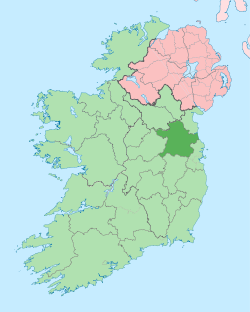- County Meath
-
County Meath
Contae na Mí
Coat of armsMotto: Tré Neart le Chéile (Irish)
"Together Strong"Country Ireland Province Leinster Dáil Éireann Meath East
Meath West
LouthEU Parliament East County seat Navan Government - Type County Council Area - Total 2,342 km2 (904.3 sq mi) Area rank 14th Population (2011) 184,034 - Rank 9th Code MH Website meath.ie County Meath (pronounced /ˈmiːð/; Irish: Contae na Mí or simply an Mhí) is a county in Ireland. It is part of the Mid-East Region and is also located in the province of Leinster. It is named after the ancient Kingdom of Mide (meaning "middle"). Meath County Council is the local authority for the county. The population of the county is 184,034 according to the 2011 census.[1]
Contents
Geography and political subdivisions
The county is drained by the River Boyne.
Meath is the 14th largest of Ireland’s 32 counties in area and 9th largest in terms of population.[2] It is the second largest of Leinster’s 12 counties in size and third largest in terms of population. The county town is Navan, where the county hall and government are located, although Trim, the former county town, has historical significance and remains a sitting place of the circuit court. County Meath also has the only two Gaeltacht areas in the province of Leinster, at Ráth Cairn and Baile Ghib.
Baronies
There are eighteen historic baronies in the county.[3] They include the baronies of Morgallion and Ratoath. While baronies continue to be officially defined units, they are no longer used for many administrative purposes. Their official status is illustrated by Placenames Orders made since 2003, where official Irish names of baronies are listed under "Administrative units".
Towns and villages
Historical populations Year Pop. ±% 1653 25,230 — 1659 29,096 +15.3% 1821 159,183 +447.1% 1831 176,826 +11.1% 1841 183,828 +4.0% 1851 140,748 −23.4% 1861 110,373 −21.6% 1871 95,558 −13.4% 1881 87,469 −8.5% 1891 76,987 −12.0% 1901 67,497 −12.3% 1911 65,091 −3.6% 1926 62,969 −3.3% 1936 61,405 −2.5% 1946 66,232 +7.9% 1951 66,337 +0.2% 1956 66,762 +0.6% 1961 65,122 −2.5% 1966 67,323 +3.4% 1971 71,729 +6.5% 1979 90,715 +26.5% 1981 95,419 +5.2% 1986 103,881 +8.9% 1991 105,370 +1.4% 1996 109,732 +4.1% 2002 134,005 +22.1% 2006 162,831 +21.5% 2011 184,034 +13.0% [4][5][6][7][8][9] - Athboy
- Ashbourne
- Ballinabrackey
- Ballivor
- Batterstown
- Bective
- Bellewstown
- Bettystown
- Carnaross
- Castletown
- Clonard
- Clonee
- Curragha
- Cushenstown
- Donore
- Drumconrath
- Duleek
- Dunboyne
- Dunderry
- Dunshaughlin
- Enfield
- Gormanston
- Johnstown
- Julianstown
- Kells
- Kilbride
- Kildalkey
- Kentstown
- Killeen
- Kinnegad
- Laytown
- Lobinstown
- Longwood
- Mornington
- Moynalty
- Mulhussey
- Navan
- Newtown
- Nobber
- Oldcastle
- Rathmolyon
- Rathbran
- Ratoath
- Skryne
- Slane
- Stamullen
- Summerhill
- Trim
Local government and politics
Main article: Meath County CouncilThere are 29 elected members of the local government authority - Meath County Council. Fianna Fáil has held three seats out of five in the Meath constituency since 1987. Fine Gael has won the other two seats at each in four of the five general elections in that period, with the exception of 1992, when it lost a seat to the Labour party (which was regained in 1997). Two constituencies are within the borders of the county: Meath East and Meath West. The constituencies also include part of the neighbouring county of Westmeath. Together they return 6 deputies to Dáil Éireann. Part of the county along the Irish Sea coast, which included Julianstown and Stamullen are part of the Louth constituency for general elections.
History
The county is colloquially known by the nickname "The Royal County" due to its history as the seat of the High King of Ireland.[10][11][12] It formed from the eastern part of the former Kingdom of Mide (see Kings of Mide) but now forms part of Leinster. Historically, the kingdom included all of the current county, all of County Westmeath and parts of counties Cavan, Longford, Louth, Offaly, Dublin and Kildare. The seat of the High King of Ireland was at Tara. The archaeological complex of Brú na Bóinne is 5,000 years old and includes the burial sites of Newgrange, Knowth and Dowth, in the north-east of the county. It is a UNESCO designated World Heritage Site.
Places of interest
- The Hill of Tara, an ancient historical site.
- Castles at Trim, Slane (private), Dunsany (limited opening), Killeen (being converted to a hotel).
- Religious ruins at Trim (two), Bective, Slane (two), Dunsany, Skryne (Skreen).
- 2500-year-old mound structures of disputed origin at Telltown.
- Brú na Bóinne Unesco World Heritage Site.
- Loughcrew, an ancient historical site.
Trim contains Ireland's largest Norman castle and was the setting for many Norman-Irish parliaments. Meath is also home to Kells, with its round tower and monastic past.
Demographics
The population in Co. Meath has been characterised since 1861 as being in a period of significant decline. Between 1861 and 1901 the population was almost halved (110,373 to 67,497), the population stabilised from 1901 to 1971 (67,497 to 71,729) and there was a substantial increase between 1971 and 1981 to 95,419. This increase was mainly due to a baby-boom locally. The population continued to increase at a constant rate, before increasing at an explosive rate between 1996 and 2002, from 109,732 to 134,005. This is due primarily to economic factors, with the return of residents to live in the county, and also an echo effect of the 70s baby boom. The census of 2006 gives a statistic of 162,831 to include a dramatic increase in inward migration in the county, much of it from neighbouring Dublin, and Drogheda.
This population growth has seen divergent trends emerge in recent years, with mild depopulation in the north and west of the county being more than offset by large increases in the population of the eastern and south eastern part of the county, principally due to inward migration to districts which have good proximity via road, to the business parks on the Western outskirts of Dublin. The accession of Poland and Lithuania to the European Union in 2004, has resulted in a significant influx of workers from these countries to work in low wage sectors including agriculture, quarrying, construction and catering.[citation needed]
Economy
- Good land, with a strong farming tradition has been prominent historically for cattle, dairying, potatoes and grain. Recently production volumes have decreased due to competition for labour from other sectors of the economy. Migrant labour from Eastern Europe has helped however. Meath is Ireland's leading county producer of potatoes, and a significant producer of beef, barley, milk, wheat, and root vegetables.
- Quarrying and Mining. Europe's largest underground lead-zinc mine, Tara Mines, has operated since 1977, at a location to the west of Navan. Current ore production from the mine is 2,600,000 tonnes of ore per year, containing over 200,000 tonnes of zinc metal. Glacial deposits of gravel exist in a band stretching from the Offaly border at Edenderry, to the sea at Laytown. This is the basis of a long running quarrying tradition. A large cement plant near Duleek is situated in this territory.
- An increasing proportion of Meath residents commute into Dublin, with a resulting shift to a services based economy in the developing dormitory towns.
- Meat processing in Clonee, and Navan.
- Historically Navan was a manufacturing town, involved in the household goods sector. Navan was the centre of the Irish Furniture industry. Gradually this has declined as a source of employment, though it has acted as a source of inspiration for other ventures producing finished products for the construction industry.
- Navan was the centre of the Irish Carpet making industry, before this was lost to overseas competition.
- Horse breeding and training.
- Localized tourism in Trim, Kells, Tara and the Boyne Valley.
- In common with other counties with thriving agricultural and traditional local industrial sectors, like Westmeath, Wexford, Kilkenny and Monaghan, Meath has few multinational investment facilities. Drogheda, Blanchardstown, Swords, and Leixlip are neighbouring towns that provide employment in this regard, however.
Transport
Road
- The M1 motorway Dublin - Belfast road.
- The M2 motorway bypasses the second largest town in the County, Ashbourne.
- The M3 motorway, linking Clonee to near the Cavan Border, a distance of 41 km.
- The M4 motorway, which is partly in County Kildare and partly in Meath.
Rail
- Hansfield, Dunboyne and M3 Parkway have a frequent service to Dublin City Centre.
- Laytown has a frequent commuter service. The station is located on Dublin's 'Northern Commuter Line'
- There is a commuter train service (Western Commuter Line) from Enfield. Although the service is very infrequent (only 8 trains a day to Dublin with no direct trains 4 pm - 9 pm), not many villages like Enfield have a commuter service at all.[citation needed]
- Navan is currently served by a spur railway line from the Dublin-Belfast main line, for freight traffic (zinc and lead concentrates from Tara Mines in Navan to Dublin Port) connecting at Drogheda. The direct rail line remains abandoned, though its path is reasonably intact, and plans are drawn up to reopen it in line with current government transport policy.
See also
- Counties of Ireland
- Lord Lieutenant of Meath
- High Sheriff of Meath
References
- ^ Census 2006 - Population of each province, county and city
- ^ Corry, Eoghan (2005). The GAA Book of Lists. Hodder Headline Ireland. pp. 186–191. ISBN 0340896957.
- ^ [http://www.logainm.ie/Viewer.aspx?text=Slane+Upper&streets=no Placenames Database of Ireland - Baronies.
- ^ For 1653 and 1659 figures from Civil Survey Census of those years, Paper of Mr Hardinge to Royal Irish Academy March 14, 1865.
- ^ Census for post 1821 figures.
- ^ http://www.histpop.org
- ^ http://www.nisranew.nisra.gov.uk/census
- ^ Lee, JJ (1981). "On the accuracy of the Pre-famine Irish censuses". In Goldstrom, J. M.; Clarkson, L. A.. Irish Population, Economy, and Society: Essays in Honour of the Late K. H. Connell. Oxford, England: Clarendon Press.
- ^ Mokyr, Joel; O Grada, Cormac (November). "New Developments in Irish Population History, 1700-1850". The Economic History Review 37 (4): 473–488. doi:10.1111/j.1468-0289.1984.tb00344.x. http://www3.interscience.wiley.com/journal/120035880/abstract
- ^ Meath County Council. "Meath - a rich and royal land". http://www.meath.ie/Tourism/Heritage/. Retrieved 21 May 2010.
- ^ countymeath.com. "County Meath - Newgrange, Slane Castle and the Book of Kells". http://www.countymeath.com/. Retrieved 21 May 2010.
- ^ Rowan Kelleher, Suzanne (2004). Frommer's Ireland from $80 a Day (20th ed.). Hoboken, New Jersey, USA: Wiley Publishing, Inc. p. 204. ISBN 0-7645-4217-6.
External links
- Meath County Council
- Meath Tourism
- Meath Event Guide
- CSO Website
- Cultur - Celebrating Diversity Website
- County Meath History Geography map guide
- Navan Hurling.com
Counties of Ireland The counties are listed per province Connacht Munster Clare · Cork (Cork City) · Kerry · Limerick (Limerick City) · Tipperary (North Tipperary • South Tipperary) · Waterford (Waterford City)
Leinster Carlow · Dublin (Dublin City • Dún Laoghaire–Rathdown • Fingal • South Dublin) · Kildare · Kilkenny · Laois · Longford · Louth · Meath · Offaly · Westmeath · Wexford · Wicklow
Ulster Italics denote non-administrative counties. Brackets denote eponymous cities or non-traditional counties. † denotes counties of Northern Ireland Categories:- County Meath
- Leinster
- Counties of the Republic of Ireland
- Local administrative units of the Republic of Ireland
Wikimedia Foundation. 2010.



